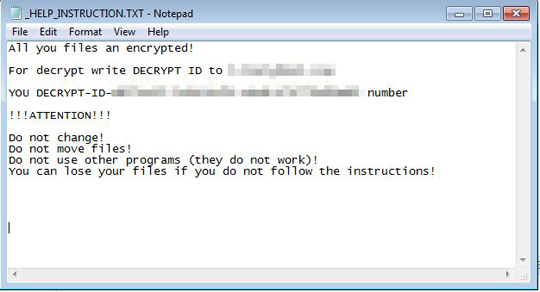RANSOM_CRYPTOMIX.R039C0DLQ17
Ransom:Win32/Cryptomix.A (Microsoft) ;Trojan-Ransom.Win32.Fury.kq (Kaspersky) ; Troj/Ransom-EUM (Sophos-Lite)
Windows


Threat Type: Ransomware
Destructiveness: No
Encrypted: No
In the wild: Yes
OVERVIEW
This Ransomware arrives on a system as a file dropped by other malware or as a file downloaded unknowingly by users when visiting malicious sites.
It drops files as ransom note.
TECHNICAL DETAILS
Arrival Details
This Ransomware arrives on a system as a file dropped by other malware or as a file downloaded unknowingly by users when visiting malicious sites.
Installation
This Ransomware drops the following copies of itself into the affected system:
- %ProgramData%\{10 Random Hex Values}.exe
(Note: %ProgramData% is the Program Data folder, where it usually is C:\Program Files in Windows 2000, Windows Server 2003, and Windows XP (32- and 64-bit); C:\ProgramData in Windows Vista (32- and 64-bit), Windows 7 (32- and 64-bit), Windows 8 (32- and 64-bit), Windows 8.1 (32- and 64-bit), Windows Server 2008, and Windows Server 2012.)
It adds the following processes:
- cmd.exe /C sc stop VVS
- cmd.exe /C sc stop wscsvc
- cmd.exe /C sc stop WinDefend
- cmd.exe /C sc stop wuauserv
- cmd.exe /C sc stop BITS
- cmd.exe /C sc stop ERSvc
- cmd.exe /C sc stop WerSvc
- cmd.exe /C vssadmin.exe Delete Shadows /All /Quiet
- cmd.exe /C bcdedit /set {default} recoveryenabled No
- cmd.exe /C bcdedit /set {default} bootstatuspolicy ignoreallfailures
It adds the following mutexes to ensure that only one of its copies runs at any one time:
- {8 RANDOM CHARACTER}_offset
Autostart Technique
This Ransomware adds the following registry entries to enable its automatic execution at every system startup:
HKEY_CURRENT_USER\Software\Microsoft\
Windows\CurrentVersion\Run
{12 Random Hex Values} = "{Malware Folder}\{Malware Name}"
HKEY_CURRENT_USER\Software\Microsoft\
Windows\CurrentVersion\Run
{10 Random Hex Values} = "%ProgramData%\{10 Random Hex Values}.exe"
HKEY_CURRENT_USER\Software\Microsoft\
Windows\CurrentVersion\RunOnce
{10 Random Hex Values} = "%ProgramData%\{10 Random Hex Values}.exe"
Other System Modifications
This Ransomware adds the following registry entries as part of its installation routine:
HKEY_CURRENT_USER\Software\Microsoft\
Windows\CurrentVersion
{8 Random Hex Values} = "{Number of Encrypted Files}"
HKEY_CURRENT_USER\Software\Microsoft\
Windows\CurrentVersion
{10 Random Hex Values} = "{Decryption Key}"
Ransomware Routine
This Ransomware avoids encrypting files with the following strings in their file name:
- _HELP_INSTRUCTION.TXT
- ntldr
- NTLDR
- NTDETECT.COM
- ntdetect.com
- Desktop
- DESKTOP
It renames encrypted files using the following names:
- {32 Random Characters}.tastylock
It drops the following file(s) as ransom note:
SOLUTION
Step 1
Before doing any scans, Windows XP, Windows Vista, and Windows 7 users must disable System Restore to allow full scanning of their computers.
Step 2
Note that not all files, folders, and registry keys and entries are installed on your computer during this malware's/spyware's/grayware's execution. This may be due to incomplete installation or other operating system conditions. If you do not find the same files/folders/registry information, please proceed to the next step.
Step 3
Delete this registry value
Important: Editing the Windows Registry incorrectly can lead to irreversible system malfunction. Please do this step only if you know how or you can ask assistance from your system administrator. Else, check this Microsoft article first before modifying your computer's registry.
- In HKEY_CURRENT_USER\Software\Microsoft\Windows\CurrentVersion\Run
- {12 Random Hex Values} = "{Malware Folder}\{Malware Name}"
- {12 Random Hex Values} = "{Malware Folder}\{Malware Name}"
- In HKEY_CURRENT_USER\Software\Microsoft\Windows\CurrentVersion\Run
- {10 Random Hex Values} = "%ProgramData%\{10 Random Hex Values}.exe"
- {10 Random Hex Values} = "%ProgramData%\{10 Random Hex Values}.exe"
- In HKEY_CURRENT_USER\Software\Microsoft\Windows\CurrentVersion\RunOnce
- *{10 Random Hex Values} = "%ProgramData%\{10 Random Hex Values}.exe"
- *{10 Random Hex Values} = "%ProgramData%\{10 Random Hex Values}.exe"
- In HKEY_CURRENT_USER\Software\Microsoft\Windows\CurrentVersion
- (8 Random Hex Values) = "{Number of Encrypted Files}"
- (8 Random Hex Values) = "{Number of Encrypted Files}"
- In HKEY_CURRENT_USER\Software\Microsoft\Windows\CurrentVersion
- {10 Random Hex Values} = "{Decryption Key}"
- {10 Random Hex Values} = "{Decryption Key}"
Step 4
Search and delete these files
- {Folder of Encrypted Files}\_HELP_INSTRUCTION.txt
Step 5
Scan your computer with your Trend Micro product to delete files detected as RANSOM_CRYPTOMIX.R039C0DLQ17. If the detected files have already been cleaned, deleted, or quarantined by your Trend Micro product, no further step is required. You may opt to simply delete the quarantined files. Please check the following Trend Micro Support pages for more information:
Step 6
Restore encrypted files from backup.
Did this description help? Tell us how we did.


